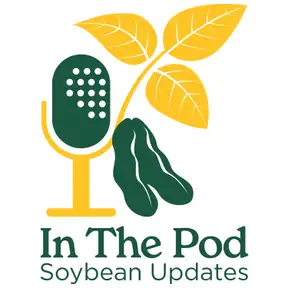Frost Takes a Bite Out of Soybeans
You're listening to In The Pod, soybean updates, a weekly trek into the latest soybean information from NDSU Extension. Recently, the region was hit with early season frost. How does frost impact soybeans at this point in the season? Anna Carcedo, NDSU Extension agronomist, will fill us in. Anna, many soybean growers experienced an early frost. Is that a problem for soybeans at this stage?
Ana Carcedo:Oh, yes. So part of North Dakota experienced frost over the weekend. We had temperatures that were actually into twenties in some areas. So when we're thinking those temperatures, we actually are thinking that it's more typical from early mid October than what we are now. We have to think also that it was not even all across the state. The coldest temperatures that we had were recorded West Of Highway 83. Yes. And your question was on the spot. So when we're talking about soybeans, the things that we have to consider when we're thinking on the damage that we had is mostly which growth stage we are and how hard the freeze or frost was. So when we are talking about soybeans, if we are thinking that we are before r six, so we are just beginning to form seeds, we are going to have a huge yield loss. We are talking about 75%, 80% of yield reductions. We are talking about a lot of yield reductions. I would say most of the soybeans in the state are past that situations, but we still have a lot of fields with r six or r 6.5. So we are saying that we are not forming the seed, but we are filling the seed. So if we are in late seed filling, we are going to talk about ten twenty percent of yield reduction. It is still a bit, but it's not as if we were in r five. And then there is also some fields that they were starting to turn color. So we are saying r seven. That is when you have at least one pod in any part of the stem that you have a pod that turned color. And then we are talking about zero to 5% yield reduction.
Bruce Sundeen:So you're talking about frost damage to soybeans at this point in the season, but how can frost damage affect the harvest? Oh, yeah. That's also an an amazing point. So soybeans that they were killed in R 6 or r seven actually should be left in the field to dry it and harvest along with the mature soybeans. Once the seed moisture, it's at the desired level, like 13% around there. Also, you have to think that the weather conditions during the field drying period, it will strongly influence the color of the seed coat. So we all have heard about having green soybeans. If during that time we have sunny, dry conditions, we are going to have that golden yellow zip code that we want to see. But if we have more freezing temperatures, snow or rain, and probably not enough sunlight, that's the key point to take that greenish color, we are going to have some problems.
Bruce Sundeen:Anna, what's the problem with green soybeans?
Ana Carcedo:When the pods and the seeds are still greenish, it's actually that the chlorophyll that it's contained there, it's not degraded. Green soybeans, you will have discounts at the elevator because of that chlorophyll removal at a cost to the processing, although the oil quality is usually less affected.
Bruce Sundeen:Thanks, Anna. Our guest has been Anna Carcedo, NDSU Extension agronomist. You're listening to In the Pod, soybean updates, a weekly trek into the latest soybean information from NDSU Extension supported by the North Dakota Soybean Council.

